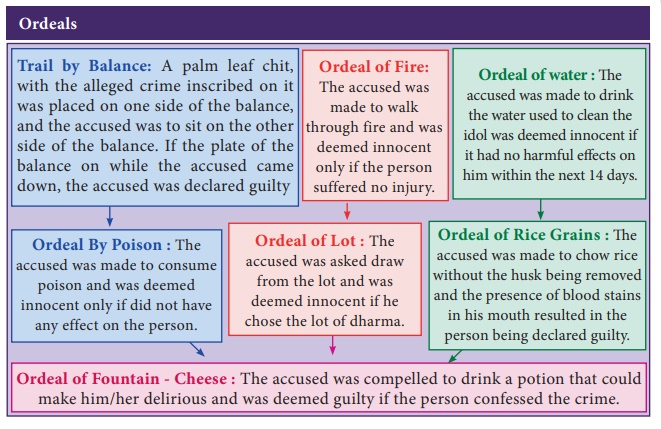Political Science - Evolution of Indian Judiciary | 12th Political Science : Chapter 4 : Indian Judiciary
Chapter: 12th Political Science : Chapter 4 : Indian Judiciary
Evolution of Indian Judiciary
Evolution of Indian Judiciary
Judicial System in Ancient India
India has been a Sub – Continent of different
races, different cultures, different languages and a multitude of political and
social systems. In ancient times, as well as in the medieval times, none of the
Indian States was segregating judicial functions from the executive. During the
Vedic period, the authority of the head of the family (Kulapa or Kulapato) was
insulated from royal interferences; Similarly the clannish or tribal bodies
like Grama, Gopa, Vishaya, Jana and Gana enjoyed autonomous powers. In the
ancient Indian monarchical orders, the king was considered to be the highest
judicial authority. As king’s will was the law, his word was the highest and
absolute verdict in disputes.
However, most of the disputes were settled and
disposed of at the local level through caste bodies or local administrative
bodies. Extreme cases like treason were tried in the king’s court. There was no
regular system of jurisprudence or judicial procedures. Most often the accused
was to prove his innocence either through evidences and witnesses or through
subjection to different kinds of ordeals such as ordeal by fire, ordeal by
water and ordeal by poison.
Punishments (penal system) was severe and even
barbaric if blood money was in vogue (less was to be replaced with material
compensation)-Whipping, flogging, amputation of limbs, impalement, rigorous
imprisonment, enslavement, banishment, confiscation of property, beheading,
hanging and trampling by elephants were some of the punishments meted out to the
culprits. In kingdoms which came under Brahmanical influence, smritis were
invoked in trial as well as in awarding punishments.
There were a number of smritis such as Manusmrit,
Narada Smriti, and Yagnavakya Smritis : of which Manu Smriti was held as a core
Smriti, other smritis had certain variatious. The Smritis generally upheld the
graded varna – Jati social order. There was no ‘equality before law’ concept.
Brahmins were mostly insulated from regular procedures and regular punishments.
On any account, Brahmins, even if they committed the most heinous crimes, were to
be exempted from physical torture, amputation, impalement or capital
punishment. On the other hand the depressed castes were subjected to severe
ordeals and extreme punishments; changing of caste based occupations was
treated (Varna Sangraha) as a serious crime.
Arthasastra suggests disproportionate punishments
for restricting instances of crimes; penalties levied on culprits, and
confiscation of properties as a major source of royal income. The smritis
treated women as inferior humans and were prejudiced against them even in
matters of inheritance. The Sudras, and Panchamas were ineligible for a fair
trial and fair punishment. Trade disputes were mostly settled through guilds
(SRENIS). Similarly each artisan group had its own guild to resolve disputes
within. The Mahasabhas of the Pallava – Pandya-Chola empires insulated Brahmins
from regular system of justice. The Mahasabha’s variyam (Dharma variam, Nyaya
variam) settled issues within the mahasabhas. The local bodies like Ur, Urar,
Nadu, Nattar and Nagarathar had their own judicial arrangements.
The Buddhist kingdoms (like that of Asoka) mostly
disregarded smritis and enforced some sort of equal treatment to various social
groups in matters of judicial disputes. Asoka removed cruel punishments and
even instructed his official to be more humane and compassionate towards
prisoners. The episode involving Kovalan’s execution in Silappadikaram reveals
the defects in the system of judicial procedure. Though high moral stature of
the adjudicating officials were insisted in literature, we very often found
arbitrariness in judicial trial and in awarding exemptions or punishments.
There was no rule of law but rule of the powerful authorities that we find in
ancient India.

In medieval India, the Muslim rulers had faced a
peculiar situation, where the majority of their subjects were Non-Muslims.
While they applied Islamic law in cases where Muslims and Muslim interests were
involved, they preferred a policy of non- intervention in the socio-religious
affairs of the Non-Muslims, hence allowed the traditional system of justice in
the rural areas. The Muslim rulers made a clear distinction between civil and
criminal disputes and assigned deferent system for each of them. However, in
cases of blasphemy, extreme punishment were awarded to the accused.
Related Topics